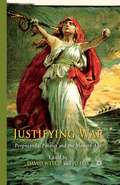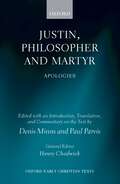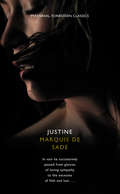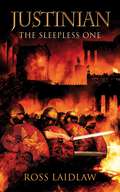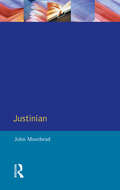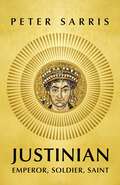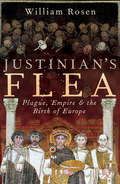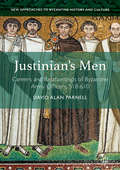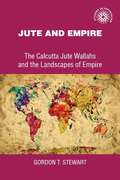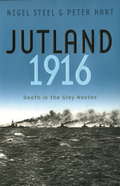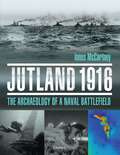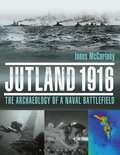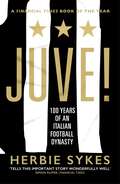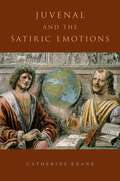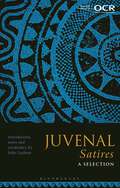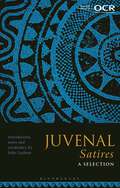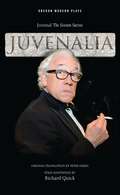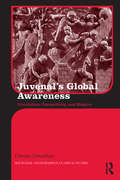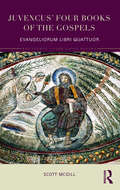- Table View
- List View
Justifying War: Propaganda, Politics and the Modern Age
by David Welch and Jo FoxA new assessment of the debates about Just War in the twentieth and twenty-first centuries, from the imperial wars of the nineteenth century through the age of total war, the evolution of human rights discourse and international law, to proportionality during the Cold War and the redefinition of authority with the ascendancy of terror groups.
Justin, Philosopher and Martyr: Apologies (Oxford Early Christian Texts)
Justin Martyr (c.100-165) was one of the key apologists of the Early Church. Oxford Early Christian Texts presents a new critical edition of the Greek text of the Apologies with introduction, English translation, and textual commentary. Editors Denis Minns and Paul Parvis take a searching look at the text transmitted by the single fourteenth-century manuscript containing the works of Justin. They attempt to see behind the work of the Byzantine editor, and his predecessors, who sought to make sense of the badly damaged text before them. The commentary is designed not merely to annotate the text but to identify and draw out Justin's train of thought and the structure of his argument. It explains the readings adopted in the text by setting Justin's Greek within his Christian, Hellenistic, and philosophical contexts. The introduction traces the complex history of the text in manuscript and print and discusses the puzzling relationship of the Second Apology to the First, and suggests a new solution. Justin is located against the background of the diversity of Christianity in the second century. A new understanding of Justin emerges from this work. His thought is often sharper, and his language more pointed than has been recognised, and the difficulty of the task he set himself of bridging the enormous gap between two cultures is clearly shown.
Justine (Harper Perennial Forbidden Classics)
by Marquis de Sade‘Justine’ was the Marquis de Sade's first novella, written in 1787, whilst imprisoned for two weeks in the Bastille. Although published anonymously, de Sade was eventually indicted for blasphemy and obscenity (without trial) for the authorship of ‘Justine’ at the behest of Napoleon Bonaparte.
Justinian: The Sleepless One
by Ross LaidlawNephew of a semi-literate peasant, Justinian I was one of the most fascinating of the Roman emperors. His reign marked a blossoming of Byzantine culture, and his prolific building works yielded such masterpieces as the church of Hagia Sophia, which remains the third largest church in Christendom. Although he never took part in military campaigns personally he managed to expand considerably the Eastern Roman Empire's territory. Justinian's wife Theodora, daughter of a bear keeper and former prostitute, was his partner in one of the greatest love stories in history. After her early death - in her forties - Justinian was devastated and sought oblivion in work, becoming known as the Emperor who never sleeps.
Justinian (The Medieval World)
by John MoorheadThe reign of Justinian (527--65) was a key phase in the transition from the Roman empire of classical times to the Byzantine empire of the Middle Ages. Justinian himself, born of peasant stock in a provincial backwater, was one of the greatest rulers yet, despite prodigious achievements, he remained an outsider in the sophisticated society of Constantinople. Here, John Moorhead reinterprets Justinian as man and monarch, together with his formidable empress, the ex-actress Theodora, and assesses the evidence from their time for the evolution of a distinctively medieval world.
Justinian (The Medieval World)
by John MoorheadThe reign of Justinian (527--65) was a key phase in the transition from the Roman empire of classical times to the Byzantine empire of the Middle Ages. Justinian himself, born of peasant stock in a provincial backwater, was one of the greatest rulers yet, despite prodigious achievements, he remained an outsider in the sophisticated society of Constantinople. Here, John Moorhead reinterprets Justinian as man and monarch, together with his formidable empress, the ex-actress Theodora, and assesses the evidence from their time for the evolution of a distinctively medieval world.
Justinian: Emperor, Soldier, Saint
by Professor Peter Sarris'A majestic, sparkling account of one of the most important rulers in history . . . this is modern history writing at its finest' Peter Frankopan'Superb and gripping. Epic historical biography that brings the emperor to life . . . filled with new ideas and revelations' Simon Sebag Montefiore'Effortlessly erudite, lucidly written, with a sharp eye for the telling detail, Sarris has written the great biography of the greatest of the Byzantine emperors' Rory StewartIn this groundbreaking new biography of Justinian, Peter Sarris gives us an intimate insight into both the Emperor and his times. We meet a man who from the humblest beginnings, rose to become ruler of much of the known world achieving an almost god-like status. An emperor who infused even the most mundane tasks with spiritual and religious significance. A gifted administrator obsessed with detail. A middle aged lover who fell for a dancing girl and changed the law so he could marry her, ruling with Empress Theodora by his side for over twenty years. A brilliant military strategist who was never on the frontline. The challenges he faced - climate change, battles over culture and identity, the first recorded global pandemic -and many of the solutions he found to address them still resonate with us today. And his legacy remains all around us, in the massive building programme of which the most beautiful manifestation is surely Hagia Sophia; in our legal systems through the codification of the Corpus juris civilis; and in our culture and history by making a fundamental contribution to both the formation of Christendom and the emergence of Islam. In this tour de force Peter Sarris shows us that in all his complexity and contradictions Justinian was, in many ways, a very modern Emperor.
Justinian's Flea: Plague, Empire and the Birth of Europe
by William RosenIn the middle of the sixth century, the world's smallest organism collided with the world's mightiest empire. With the death of twenty-five million people, the Roman Empire, under her last great emperor, Justinian, was decimated. Before Yersinia pestis, the bacterium that carries bubonic plague, was finished, both the Roman and Persian empires were easy pickings for the armies of Muhammad on their conquering march out of Arabia. In its wake, the plague - history's first pandemic - marked the transition from the age of Mediterranean empires to the age of European nation-states - from antiquity to the medieval world.A narrative history that melds contemporary sources with modern disciplines, Justinian's Flea is a unique account of one of history's great turning points - the summer of 542 - revealed through the experiences of the remarkable individuals whose lives are a window onto a remarkable age: Justinian, his general Belisarius, the greatest soldier between Caesar and Saladin; his architect, Anthemius who built Constantinople's Hagia Sophia (and whose brother, Alexander, was the great physician of the plague years); Tribonian, the jurist who created the Justinianic Code; and, finally, his empress Theodora, the one-time prostitute who became co-ruler of the empire, the most politically powerful woman in European history until Elizabeth I.
Justinian's Men: Careers and Relationships of Byzantine Army Officers, 518-610 (New Approaches to Byzantine History and Culture)
by David Alan ParnellThis book explores the professional and social lives of the soldiers who served in the army of the Byzantine Empire in the sixth century. More than just a fighting force, this army was the setting in which hundreds of thousands of men forged relationships and manoeuvred for promotion. The officers of this force, from famous generals like Belisarius and Narses to lesser-known men like Buzes and Artabanes, not only fought battles but also crafted social networks and cultivated their relationships with their emperor, fellow officers, families, and subordinate soldiers. Looming in the background were differences in identity, particularly between Romans and those they identified as barbarians. Drawing on numerical evidence and stories from sixth-century authors who understood the military, Justinian’s Men highlights a sixth-century Byzantine army that was vibrant, lively, and full of individuals working with and against each other.
Jute and empire (Studies in Imperialism)
by Gordon StewartDundee had an interesting role to play in the jute trade, but the main player in the story of jute was Calcutta. This book follows the relationship of jute to empire, and discusses the rivalry between the Scottish and Indian cities from the 1840s to the 1950s and reveals the architecture of jute's place in the British Empire. The book adopts significant fresh approaches to imperial history, and explores the economic and cultural landscapes of the British Empire. Jute had been grown, spun and woven in Bengal for centuries before it made its appearance as a factory-manufactured product in world markets in the late 1830s. The book discusses the profits made in Calcutta during the rise of jute between the 1880s and 1920s; the profits reached extraordinary levels during and after World War I. The Calcutta jute industry entered a crisis period even before it was pummelled by the depression of the 1930s. The looming crisis stemmed from the potential of the Calcutta mills to outproduce world demand many times over. The St Andrew's Day rituals in Calcutta, begun three years before the founding of the Indian Jute Mills Association. The ceremonial occasion helps the reader to understand what the jute wallahs meant when they said they were in Calcutta for 'the greater glory of Scotland'. The book sheds some light on the contentious issues surrounding the problematic, if ever-intriguing, phenomenon of British Empire. The jute wallahs were inextricably bound up in the cultural self-images generated by British imperial ideology.
Jutland, 1916: Death in the Grey Wastes (Sven Hassel War Classics)
by Peter Hart Nigel SteelDramatic, illustrated account of the biggest naval battle of the First World War.On 31 May, 1916, the great battle fleets of Britain and Germany met off Jutland in the North Sea. It was a climactic encounter, the culmination of a fantastically expensive naval race between the two countries, and expectations on both sides were high. For the Royal Navy's Grand Fleet, there was the chance to win another Trafalgar. For the German High Seas Fleet, there was the opportunity to break the British blockade and so change the course of the war. But Jutland was a confused and controversial encounter. Tactically, it was a draw; strategically, it was a British victory.Naval historians have pored over the minutiae of Jutland ever since. Yet they have largely ignored what the battle was actually like for its thousands of participants. Full of drama and pathos, of chaos and courage, JUTLAND, 1916 describes the sea battle in the dreadnought era from the point of view of those who were there.
Jutland 1916: The Archaeology of a Naval Battlefield
by Innes McCartneyThe Battle of Jutland was the largest naval battle and the only full-scale clash of battleships in the First World War. For years the myriad factors contributing to the loss of many of the ships remained a mystery, subject only to speculation and theory. In this book, marine archaeologist and historian Dr Innes McCartney reveals for the first time what became of the warships that vanished on the night of 31st May 1916, examining the circumstances behind the loss of each ship and reconciling what was known in 1916 to what the archaeology is revealing today. The knowledge of what was present was transformed in 2015 by a groundbreaking survey using the modern technology of multi-beam. This greatly assisted in unravelling the details behind several Jutland enigmas, not least the devastating explosions which claimed five major British warships, the details of the wrecks of the 13 destroyers lost in the battle and the German warships scuttled during the night phase. This is the first book to identify the locations of many of the wrecks, and – scandalously – how more than half of these sites have been illegally plundered for salvage, despite their status as war graves. An essential and revelatory read for anyone interested in naval history and marine archaeology.
Jutland 1916: The Archaeology of a Naval Battlefield
by Innes McCartneyThe Battle of Jutland was the largest naval battle and the only full-scale clash of battleships in the First World War. For years the myriad factors contributing to the loss of many of the ships remained a mystery, subject only to speculation and theory. In this book, marine archaeologist and historian Dr Innes McCartney reveals for the first time what became of the warships that vanished on the night of 31st May 1916, examining the circumstances behind the loss of each ship and reconciling what was known in 1916 to what the archaeology is revealing today. The knowledge of what was present was transformed in 2015 by a groundbreaking survey using the modern technology of multi-beam. This greatly assisted in unravelling the details behind several Jutland enigmas, not least the devastating explosions which claimed five major British warships, the details of the wrecks of the 13 destroyers lost in the battle and the German warships scuttled during the night phase. This is the first book to identify the locations of many of the wrecks, and – scandalously – how more than half of these sites have been illegally plundered for salvage, despite their status as war graves. An essential and revelatory read for anyone interested in naval history and marine archaeology.
Jutland 1916: The Archaeology of a Naval Battlefield
by Innes McCartneyThe Battle of Jutland was the largest naval battle and the only full-scale clash of battleships in the First World War. For years the myriad factors contributing to the loss of many of the ships remained a mystery, subject only to speculation and theory. In this book, marine archaeologist and historian Dr Innes McCartney reveals for the first time what became of the warships that vanished on the night of 31st May 1916, examining the circumstances behind the loss of each ship and reconciling what was known in 1916 to what the archaeology is revealing today. The knowledge of what was present was transformed in 2015 by a groundbreaking survey using the modern technology of multi-beam. This greatly assisted in unravelling the details behind several Jutland enigmas, not least the devastating explosions which claimed five major British warships, the details of the wrecks of the 13 destroyers lost in the battle and the German warships scuttled during the night phase. This is the first book to identify the locations of many of the wrecks, and – scandalously – how more than half of these sites have been illegally plundered for salvage, despite their status as war graves. An essential and revelatory read for anyone interested in naval history and marine archaeology.
Juve!: 100 Years of an Italian Football Dynasty
by Herbie SykesThe definitive history of the iconic football club: the glory, the scandal, the stars and its enduring influence on Italian life.Juventus utterly dominates the Italian game. Home to some of the biggest names in sport, it has won title after title, trophy after trophy. However, parallel to the success and myth, there’s a murkier reality. For one hundred years the club and its billionaire owners, the Agnelli family, have been synonymous with match-fixing, doping, political chicanery and more. While La Vecchia Signora remains Italy’s best-supported team, it’s also its most despised.Juve! charts the story of Italy’s great sporting dynasty, chronicling the triumphs and tragedies of the Agnellis, and of the icons – Boniperti, Del Piero, Ronaldo – who have been their sporting emissaries for almost a century. The pride of Italy or its dark heart? Footballing colossus or vanity project? With this unique institution, as with so much about life in Italy, things are seldom black and white…
Juvenal and the Satiric Emotions
by Catherine KeaneIn his sixteen verse Satires, Juvenal explores the emotional provocations and pleasures associated with social criticism and mockery. He makes use of traditional generic elements such as the first-person speaker, moral diatribe, narrative, and literary allusion to create this new satiric preoccupation and theme. Juvenal defines the satirist figure as an emotional agent who dramatizes his own response to human vices and faults, and he in turn aims to engage other people's feelings. Over the course of his career, he adopts a series of rhetorical personae that represent a spectrum of satiric emotions, encouraging his audience to ponder satire's proper emotional mode and function. Juvenal first offers his signature indignatio with its associated pleasures and discomforts, then tries on subtler personae that suggest dry detachment, callous amusement, anxiety, and other affective states. As Keane shows, the satiric emotions are not only found in the author's rhetorical performances, but they are also a major part of the human farrago that the Satires purport to treat. Juvenal's poems explore the dynamic operation of emotions in society, drawing on diverse ancient literary, rhetorical, and philosophical sources. Each poem uniquely engages with different texts and ideas to reveal the unsettling powers of its emotional mode. Keane also analyzes the "emotional plot" of each book of Satires and the structural logic of the entire series with its wide range of subjects and settings. From his famous angry tirades to his more puzzling later meditations, Juvenal demonstrates an enduring interest in the relationship between feelings and moral judgment.
Juvenal and the Satiric Emotions
by Catherine KeaneIn his sixteen verse Satires, Juvenal explores the emotional provocations and pleasures associated with social criticism and mockery. He makes use of traditional generic elements such as the first-person speaker, moral diatribe, narrative, and literary allusion to create this new satiric preoccupation and theme. Juvenal defines the satirist figure as an emotional agent who dramatizes his own response to human vices and faults, and he in turn aims to engage other people's feelings. Over the course of his career, he adopts a series of rhetorical personae that represent a spectrum of satiric emotions, encouraging his audience to ponder satire's proper emotional mode and function. Juvenal first offers his signature indignatio with its associated pleasures and discomforts, then tries on subtler personae that suggest dry detachment, callous amusement, anxiety, and other affective states. As Keane shows, the satiric emotions are not only found in the author's rhetorical performances, but they are also a major part of the human farrago that the Satires purport to treat. Juvenal's poems explore the dynamic operation of emotions in society, drawing on diverse ancient literary, rhetorical, and philosophical sources. Each poem uniquely engages with different texts and ideas to reveal the unsettling powers of its emotional mode. Keane also analyzes the "emotional plot" of each book of Satires and the structural logic of the entire series with its wide range of subjects and settings. From his famous angry tirades to his more puzzling later meditations, Juvenal demonstrates an enduring interest in the relationship between feelings and moral judgment.
Juvenal Satires: A Selection
by John GodwinThis is the OCR-endorsed edition covering the Latin AS and A-Level (Group 3) prescription of Juvenal, Satire 6 and the A-Level (Group 4) prescription of Satires 14 and 15, giving full Latin text, commentary and vocabulary, with a detailed introduction that also covers the prescribed material to be read in English for A Level. Juvenal was the last and the greatest of the Roman verse satirists and his poetry gives us an exuberant and outrageously jaundiced view of the early Roman Empire. This book contains a selection from three of his satires: Satire 6 attacks women and marriage, Satire 14 critiques the role played by parents in the education of children and Satire 15 describes all too vividly the cannibalism perpetrated by warring Egyptians. These Satires expose the folly and the wickedness of the world in some of the finest Latin to have survived from antiquity.Supporting resources are available on the Companion Website: https://www.bloomsbury.pub/OCR-editions-2024-2026
Juvenal Satires: A Selection
This is the OCR-endorsed edition covering the Latin AS and A-Level (Group 3) prescription of Juvenal, Satire 6 and the A-Level (Group 4) prescription of Satires 14 and 15, giving full Latin text, commentary and vocabulary, with a detailed introduction that also covers the prescribed material to be read in English for A Level. Juvenal was the last and the greatest of the Roman verse satirists and his poetry gives us an exuberant and outrageously jaundiced view of the early Roman Empire. This book contains a selection from three of his satires: Satire 6 attacks women and marriage, Satire 14 critiques the role played by parents in the education of children and Satire 15 describes all too vividly the cannibalism perpetrated by warring Egyptians. These Satires expose the folly and the wickedness of the world in some of the finest Latin to have survived from antiquity.Supporting resources are available on the Companion Website: https://www.bloomsbury.pub/OCR-editions-2024-2026
Juvenalia (Oberon Modern Plays)
by Richard QuickSimon Callow does stand-up comedy. Filthy, foul mouthed, viciously funny and deeply politically incorrect. The target: immigrants, plutocrats, women, gays. As last delivered in Rome AD 100. Juvenal was one angry white middle-class male. In Juvenalia he tells it like it was. And is. The writer, Juvenal born circa AD55, wrote sixteen satires that attacked the decadence of Rome in its heyday. Here, adapted by Richard Quick, we are given a view into the moral decline that is as relevant now, as it was back then.
Juvenal's Global Awareness: Circulation, Connectivity, and Empire (Routledge Monographs in Classical Studies)
by Osman UmurhanIn Juvenal’s Global Awareness Osman Umurhan applies theories of globalization to an investigation of Juvenal’s articulation and understanding of empire, imperialism and identity. Umurhan explains how the increased interconnectivity between different localities, ethnic and political, shapes Juvenal’s view of Rome as in constant flux and motion. Theoretical and sociological notions of deterritorialization, time-space compression and the rhizome inform the satirist’s language of mobility and his construction of space and place within second century Rome and its empire. The circulation of people, goods and ideas generated by processes of globalization facilitates Juvenal’s negotiation of threats and changes to Roman institutions that include a wide array of topics, from representatios of the army and food to discussions of cannibalism and language. Umurhan’s analysis stresses that Juvenalian satire itself is a rhizome in both function and form. This study is designed for audiences interested in Juvenal, empire and globalization under Rome.
Juvenal's Global Awareness: Circulation, Connectivity, and Empire (Routledge Monographs in Classical Studies)
by Osman UmurhanIn Juvenal’s Global Awareness Osman Umurhan applies theories of globalization to an investigation of Juvenal’s articulation and understanding of empire, imperialism and identity. Umurhan explains how the increased interconnectivity between different localities, ethnic and political, shapes Juvenal’s view of Rome as in constant flux and motion. Theoretical and sociological notions of deterritorialization, time-space compression and the rhizome inform the satirist’s language of mobility and his construction of space and place within second century Rome and its empire. The circulation of people, goods and ideas generated by processes of globalization facilitates Juvenal’s negotiation of threats and changes to Roman institutions that include a wide array of topics, from representatios of the army and food to discussions of cannibalism and language. Umurhan’s analysis stresses that Juvenalian satire itself is a rhizome in both function and form. This study is designed for audiences interested in Juvenal, empire and globalization under Rome.
Juvenal’s Tenth Satire
by Professor Paul MurgatroydThis is not a commentary on Juvenal Satire 10 but a critical appreciation of the poem which examines it on its own and in context and tries to make it come alive as a piece of literature, offering one man’s close reading of Satire 10 as poetry, and concerned with literary criticism rather than philological minutiae. In line with the recent broadening of insight into Juvenal’s writing this book often addresses the issues of distortion and problematizing and covers style, sound and diction as well. Much time is also devoted to intertextuality and to humour, wit and irony. Building on the work of scholars like Martyn, Jenkyns and Schmitz, who see in Juvenal a consistently skilful and sophisticated author, this is a whole book demonstrating a high level of expertise on Juvenal’s part sustained throughout; a long poem (rather than intermittent flashes). This investigation of 10 leads to the conclusion that Juvenal is an accomplished poet and provocative satirist, a writer with real focus, who makes every word count, and a final chapter exploring Satires 11 and 12 confirms that assessment. Translation of the Latin and explanation of references are included so that Classics students will find the book easier to use and it will also be accessible to scholars and students interested in satire outside of Classics departments.
Juvencus' Four Books of the Gospels: Evangeliorum Libri Quattuor (Routledge Later Latin Poetry)
by Scott McGillJuvencus’ Evangeliorum libri IV, or "The Four Books of the Gospels," is a verse rendering of the gospel narrative written ca. 330 CE. Consisting of around 3200 hexameter lines, it is the first of the Latin "Biblical epics" to appear in antiquity, and the first classicizing, hexameter poem on a Christian topic to appear in the western tradition. As such, it is an important text in literary and cultural history. This is the first English translation of the entire poem. The lack of a full English translation has kept many scholars and students, particularly those outside of Classics, and many educated general readers from discovering it. With a thorough introduction to aid in the interpretation and appreciation of the text this clear and accessible English translation will enable a clearer understanding of the importance of Juvencus’ work to later Latin poetry and to the early Church.
Juvencus' Four Books of the Gospels: Evangeliorum Libri Quattuor (Routledge Later Latin Poetry)
by Scott McGillJuvencus’ Evangeliorum libri IV, or "The Four Books of the Gospels," is a verse rendering of the gospel narrative written ca. 330 CE. Consisting of around 3200 hexameter lines, it is the first of the Latin "Biblical epics" to appear in antiquity, and the first classicizing, hexameter poem on a Christian topic to appear in the western tradition. As such, it is an important text in literary and cultural history. This is the first English translation of the entire poem. The lack of a full English translation has kept many scholars and students, particularly those outside of Classics, and many educated general readers from discovering it. With a thorough introduction to aid in the interpretation and appreciation of the text this clear and accessible English translation will enable a clearer understanding of the importance of Juvencus’ work to later Latin poetry and to the early Church.
